Dec 16, 2025
Dec 16, 2025
Abstract
Mahabharata war is considered by many to be a historical event. The epic states that a singularly ominous pair of eclipses occurred in - Thirteen days - some time before the war. Using modern astronomical software, our article shows that a number of Thirteen day eclipse pairs were visible in Kurukshethra. Article suggests some candidate dates for Mahabharata war.
Introduction
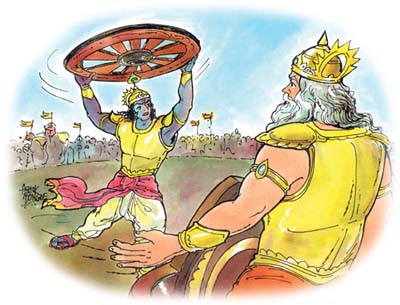 Mahabharata is a great epic, and is one of the pillars of present day Hinduism. The Mahabharata story and its moral ethos have had profound influence on millions over many generations. Mahabharata war is said to have occurred before the transition of Dwapara Yuga to Kali Yuga. Dating the Mahabharata war and start of Kaliyuga has been elusive and going on for many centuries.
Mahabharata is a great epic, and is one of the pillars of present day Hinduism. The Mahabharata story and its moral ethos have had profound influence on millions over many generations. Mahabharata war is said to have occurred before the transition of Dwapara Yuga to Kali Yuga. Dating the Mahabharata war and start of Kaliyuga has been elusive and going on for many centuries.
Aryabhata, is a famous early astronomer with contributions to science, whose estimate of p, and the time of moon revolution around the earth are so accurate, that his works are being extensively researched. Aryabhata (476-550 AD) stated that Kaliyuga started 3600 years before, when he was 23 years old, making the start as 3102 BC [Aryabhateeya ref-1]). It would date Mahabharata war to around circa 3130-3140 BCJ.
Surya Siddhanta [Ref 2], a document evolved from roughly same period, states that sun was 54 degrees away from vernal equinox when Kaliyuga started on a new moon day, corresponding to February 17/18, 3102 BCJ, at Ujjain (75deg47minE 23deg 15min N).
 Varaha Mihira (circa 560 AD), another famous astronomer, stated that 2526 years before start of Saka count (either Shalivahana saka starting in 79 AD or Vikrama Saka starting in 57 BC) [Brihat Samhita Ref-3].
Varaha Mihira (circa 560 AD), another famous astronomer, stated that 2526 years before start of Saka count (either Shalivahana saka starting in 79 AD or Vikrama Saka starting in 57 BC) [Brihat Samhita Ref-3].
When Saptarishis (ursa major) was near Magha Yudhistira was king 2526 years before Saka time
Presently, traditional Sanatana Dharma followers consider that Kaliyuga started at 3102 BCJ, when Sri Krishna passed away, and that Mahabharata war occurred in 3138 BCJ. Millennium year 2000 AD is Kali 5102.
Like Homer's Iliad, another epic poetry from Greece, different scholars have expressed opinions varying between the story of Mahabharata being either total fiction or true record of historical facts. It took efforts by Schliemann and others to show physical archeological evidence of existence of Troy in present day Turkey, and Homer's poems having historical relevance.
Bharata has been continuously and relatively densely lived in for thousands of years and in Northern Bharata the archeological evidence is difficult to come by because of many 100's of generations of people living in same area. Hence, it is usual to look for Puranic and Vedic (written and oral recitation) astronomical evidence to substantiate the time periods. As is true of all such documents like bible stories, Scandinavian, Chinese, Japanese, Egyptian and other documented local folklore, the historical truths are likely to be anywhere between absolute truth to vivid imagination. An objective analysis can help in determining the likelihood of folklore being a historical fact or not.
Mahabharata
Mahabharata epic story was written by, Vedavyaasa (or Krishna Dwaipaayana) after the Mahabharata war. Vyaasa is also credited with codifying the existing branches of Vedas. It is perhaps the longest poem of its kind of such antiquity. The presently known oldest version of Mahabharata, based on its style, grammar and other features was probably written down before the Gupta period. This Mahabharata text does not refer to any Zodiac's or Raashis (a western concept probably accommodated in to Jyotishya some time during 300BC to 200AD). The linguistic style of the oldest version of Mahabharata clearly cannot be the basis for determining if and when the events of Mahabharata occurred. It probably may have been rewritten/re-rendered many times as the mode of transference was by oral traditions as in the case of Vedic chandas prosody. The known oldest version has nearly 90,000 to 100,000 poems dominantly with 32 syllables Anushtup chandas, in 18 chapters called Parva's [ref-4 and 5].
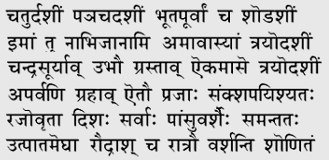 The Bhishma Parva and Udyoga Parva (specific chapters of Mahabharata) provide considerable astronomical/astrological descriptions and omens as the Mahabharata war was approaching. It describes a period of draught, with many planetary positions. Then there is this clear reference to pair of eclipses occurring on 13th day as shown below.
The Bhishma Parva and Udyoga Parva (specific chapters of Mahabharata) provide considerable astronomical/astrological descriptions and omens as the Mahabharata war was approaching. It describes a period of draught, with many planetary positions. Then there is this clear reference to pair of eclipses occurring on 13th day as shown below.
Fourteenth day, Fifteenth day and in past sixteenth day, but I have never known the Amavasya (New Moon day) to occur on the thirteenth day. Lunar eclipse followed by solar eclipse on thirteenth day is in a single lunar month etc...
This reference to Thirteen day eclipse pair appears to be a unique astronomical observation.
Mahabharata text also refers to retrograde motions of planets prior to war and provides their location with reference to 27/28 Vedic star locations. Mahabharata Drona Parva also refers to Jayadhratha's killing during a dark episode on 13th day of the war, which some consider as another short solar eclipse.
This document is basically concerned with analysis of all eclipses visible at Kurukshethra (Location where Mahabharata war took place, north of New Delhi, Longitude 76 deg 49 min East, Latitude 29 deg 59 Min North) from 3300 BC to about Buddha-Mahavira-Parshvanaatha time of about 700BC. Analysis of the time between successive eclipses, specifically time between end of one and beginning of other has been made, with a view to look at astronomical feasibility of back-to-back eclipses in 13 days, using modern astronomical computer software.
Another major issue of how did observers of the period define and determine period between eclipses when no clocks existed, has been addressed.
Eclipses
Lunar eclipse occurs when Earth's shadow falls on the Moon. There are about 150 lunar eclipses per century. Lunar eclipses can occur only at full moon, and can be either total or partial. Further they can be umbral and or penumbral. Total lunar eclipses can last up to 2 hours, while partial lunar eclipses can last up to 4 hours. Any observer on dark face of earth can see when lunar eclipse when it occurs. During period 3500BC to 700 BC, nearly 4350 lunar eclipses have probably occurred. A good fraction of these would have been visible in Kurukshethra [ref-6].
Solar Eclipse occurs when Moon's shadow falls on earth observer. About 240 solar eclipses occur every century. During period 3500BC to 700 BC, nearly 6960 Solar Eclipses have occurred. Solar can occur only at new moon. Solar eclipses may be total or annular. Total solar eclipses can last up to about 8 minutes, and partial solar eclipses can last up to 115minutes. The shadow of moon has a limited size of few thousand miles falling on nearly 8000-mile diameter earth. Hence, solar eclipses can be seen only in a limited range of longitude-latitude where the shadow falls. Elsewhere, even though sun is visible, eclipse will not be seen.
Eclipse evaluating computational software and its validation in present context
Astronomical calculations have been greatly improved since past 30 years, particularly with considerable amount of trajectory work conducted in Moon and other scientific projects. High accuracy computer models and software have been developed. These are validated against databases from US Naval Observatory's Interactive computer Ephemeris, and Jet Propulsion Laboratory in California. One such code is LodeStar Pro copy righted by Wayne C Annala in 1994 [Ref- 7]. The Lodestar Pro was checked for historical eclipses of 1000-2500 BC from clay tablet records of Mesopotamia area presently available with British Museum. Wayne Mitchell has analyzed this data [Ref-8]. Lodestar Pro provided excellent match with ref-8.
Eclipses at Kurukshethra
During the period of our interest, 3500BC to 700 BC, nearly 4350 Lunar Eclipses and 6960 solar eclipses have occurred on earth. Of these nearly 673 solar and lunar eclipses occurred in pairs of time gap of about nominal 15 days corresponding to roughly half lunar month. We need to search amongst these 673 for eclipse pairs visible in Kurukshethra, which occurred in 'Thirteen' days.
A very detailed scan of all the visible lunar and solar eclipses for every year from 3300BC to 700 BC was made on the Lodestar software for Kurukshethra location. These are tabulated and plotted. Maximum eclipse time gap (end of one eclipse and beginning of next eclipse for naked eye observers) was found to be about 379 hours while the minimum was about 332 hours. A plot of time gap between back-to-back eclipses versus eclipse pair number is shown below. (This time corresponds to maximum to maximum - not end of one to beginning of next as in the future table).
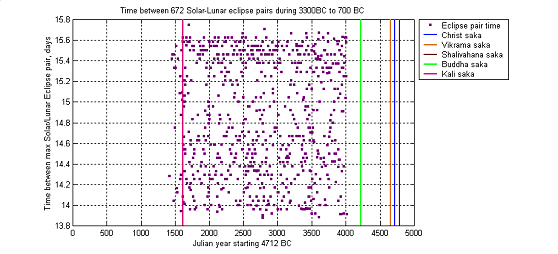
The plot shows that during the period 3300BC to 700 BC, (Julian year corresponds to zero at 4712 BC- an imaginary date- Our range corresponds to 1412 Julian year to 4012 Julian Year) nearly 672 pairs of eclipses occurred on earth, which in principle may have been visible at Kurukshethra. Amongst these, nearly 32 pairs would be occurring for period less than 14 days. Many of these were found to be weak penumbral eclipses of moon, and solar eclipses had such low obscurity as to raise the issue whether any body could see them. Six pairs of 'thirteen day' eclipses could be seen unambiguously.
Definition of Day and issue of timing determination
It is easy for us, in present time, to precisely analyze the eclipse times based on a 24 hour per day time clock. However many thousand years ago, such a time evaluation would clearly be irrelevant. Hence the count of the day and time had to be based on clear, natural and unambiguous events such as sunset to sunset or sunrise to sun rise. Hence in all the analyses, presented below, the time of relevant sun rise or sun set is indicated such that the eclipse beginning and end can be evaluated with reference to the sun rise or sun set. In modern day definition, the period from sunrise to next sunrise is never 24 hours except on equinox day. On all other days, the time will be either less than 24 hours (when day light time is shrinking) and more than 24 hours (when day light time is increasing). For people of ancient times, sunset-to-sunset or sunrise-to-sunrise would be the logical definition of a day. Using this definition, it is possible to determine whether an eclipse pair occurred in 'Thirteen days'.
Kurukshethra eclipses and some planetary retrograde motions
The table below shows six pairs of eclipses, which can be analyzed further to determine whether Mahabharata war and events could occur then.
Six eclipse pairs visible at Kurukshethra occurring in less than or near 14 days
Events in red not visible due to sun rise (Lunar) or sun set (Solar)
Year BC Eclipse Julian day Initial con Max End Sunrise Sunset end/start date
|
Year BC |
Eclipse | Julian Day |
Initial |
Max |
End |
Sunrise |
Sunset |
End/Strt Dt |
| 3129 | Solar | Aug 11 | 18:53:48 | 19:48:04 | 20:38:54 | 19:22 | 13d20h20m | |
| 3129 | Lunar | Aug 25 | 16:58:50 | 18:21:36 | 19:44:21 | 19:17 | ||
| 2529 | Solar | Jul 11 | 03:50:53 | 04:36:27 | 05:24:36 | 05:12 | 13d20h8m | |
| 2529 | Lunar | Jun 27 | 03:29:54 | 05:13:45 | 06:57:36 | 05:07 | ||
| 2056 | Solar | Nov 25 | 16:50:19 | 17:52:24 | 18:48:02 | 17:38 | 13d21h40m | |
| 2056 | Lunar | Dec 09 | 16:27:47 | 18:12:55 | 19:58:05 | 17:32 | ||
| 1853 | Solar | Dec 30 | 15:47:28 | 17:00:02 | 18:03:38 | 17:29 | 13d22h14m | |
| 1853 | Lunar | Jan 13 | 16:17:56 | 17:24:16 | 18:30:37 | 17:36 | ||
| 1708 | Solar | Mar 27 | 04:55:14 | 05:47:28 | 06:44:15 | 06:37 | 13d20h18m | |
| 1708 | Lunar | Apr 10 | 03:02:36 | 04:46:36 | 06:30:55 | 06:19 | ||
| 1397 | Solar | Jul 04 | 19:00:34 | 19:36:54 | 20:11:34 | 19:21 | 13d21h30m | |
| 1397 | Lunar | Jul 18 | 17:41:38 | 19:34:00 | 21:26:30 | 19:23 |
Location of Kurukshethra 76 deg 49 min East, 29 deg 59 min North
After serious analysis of all the eclipses, six eclipse pairs from 3129 BCJ, 2599 BCJ, 2056 BCJ, 1853 BCJ, 1708 BCJ and 1397 BCJ clearly are the best candidates for Mahabharata war year from 'thirteen day' eclipse pairs view point. There are others that have low obscurity for solar eclipse, or have dominant penumbral lunar eclipse content and hence do not constitute strong candidates for the Mahabharata war.
One typical eclipse pair of the six is illustrated using Lodestar Pro views of the relevant sunset/sunrise periods. The light/day transition is clearly shown in all the eclipse, which would form the only method of determining that the eclipses occurred in less than fourteen days, which has to be called thirteen-day eclipses. Planets Sani (Saturn) and Brihaspati (Jupiter), Shukra (Venus) in retrograde motion are illustrated for period around the eclipse pairs.
Solar-Lunar eclipse pair from Julian year 3129 BC
|
|
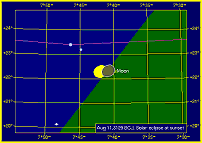 |
|
|
|
|
Fourteen days later at same time |
|
|
|
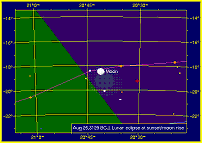 |
|
|
|
Let us now look at how any observer can study these eclipses and conclude that the pair occurred in 'Thirteen days'. The figures above show the pictures of day/night sky for a pair of Solar-Lunar eclipses, end of lunar eclipse being only 13 days and 20 hours before start of a solar eclipse. On Julian August 11 afternoon, a solar eclipse begins 20 minuets before sunset and it is still on going at sunset. Fourteen days later (On Julian August 25) in the evening at sunset a lunar eclipse is already occurring. It clearly suggests that eclipse started on the 13th day after the previous eclipse! Obviously the end of lunar and start of solar eclipses were less than 14 days period, or occurred in 13 days. This could be concluded without the benefit of modern clocks.
The dates of this eclipse pair are Julian 3129 and Julian month of August. In ancient Bharata, since the full moon occurred on Proshtapada, the month would be considered as Bhadrapada. Normally, this is the monsoon rainy season in North India. However, there are many occasions when monsoon fails. The epic states that draught like conditions existed. Even during normal monsoon the sky is occasionally clear for the eclipses to have been witnessed.
The two planets Jupiter, and Saturn are in motion (vakri) and these do occur during 3129 JBC as illustrated below. Motion of Angaraka or Mars is normal.
|
|
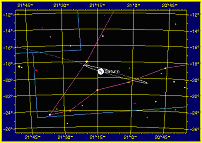 |
Items in red show retrograde or Vakri motion
| Graha (Planet) | 3129BCJ | Mahabharata text |
| Brihaspati (Jupiter) | U.Ashada/Shravana | Shravana-Vishakha |
| Sani (Saturn) | Revati | Shravana-Vishakha |
| Angaraka (Mars) | U.Ashada/Shravana | Magha |
| Shukra (Venus) | U Phalguni | Poorva Phalguni |
| Ravi (Sun Solar) | U Phalguni | Rohini |
23-Feb-2002
More by : Dr. S. Balakrishna

|
Interesting Analysis.. thanks for effort sir.. |

|
i want to buy a book wherein i could understand meanings of each astro-nakshtra , how it is named and consequences results.effects of those stars..relating to vedic astrology AND FROM WHERE I CAN BUY phone 9908891156 |

|
Hi Dr. Balakrishna, First of all thanks a lot for this effort and research, I would like to request you if you could make a YouTube video of this research that will help lots of other guys to understand this clearly. Thanks in advance!!!!! |

|
I was coming back from ISKON today wondering all the way about Krishna and The Epic Mahabharata. I thought the exact date could be calculated using the astronomical references from Mahabharata. And then I find this article. What a hybrid of Science and Sprituality. Dr Balakrishna, thank you for your efforts and time. It has made for an interesting read. They allege that there were settlers around 10000 BC around the Egyptian pyramids. Why is a lot of information and access to certain areas of the Egyptian pyramids being forbidden ?? I have a strong thought that somewhere between and 10000 BC and today, a lot of knowledge and tech has been lost. Nothing unscientific though. ( how were the pyramids built ??? ) I would love to see that day when all lost world's knowledge returns. In one episode of Cosmos, Niel says that the ice age stopped some 15-25 k years ago. About 10k years ago, the earths climate stabilized. And the human civilisation starts on fertile river delta plains. Niel may be few thousand years off, but our civilizational history is certainly 10k years old for sure, at least. This article has been a great fodder for my curiosity. |

|
The whole effort by the author is a bit not clear to me. During the Mahabharat war which occurred first - a solar eclipse or a lunar eclipse ? If the blocking of sun when Jayadrath was killed took place because of a solar eclipse, and if the eclipses occurred within 13 days, a natural guess is that the lunar eclipse took place first followed by the solar eclipse. In such a case the table ( Six eclipse pairs visible at Kurukshethra occurring in less than or near 14 days) given by the author is reduced to naught unless there is a blunder in column 2 of the table. Certainly a clarification is desired on the above. |

|
Research of S Balarkishna on two eclipse within 13 days is excellent. His proposed/plausible dates for Mahabharata War are NOT. One of the reasons, of course, is that we searched for them in the wrong region, partly driven by conjectures of Aryabhatta and Varahamihir for beginning of Kaliyuga. Read - When did the Mahabharata War Happen? The Mystery of Arundhati.. |

|
A small error, re. Manasyu: Manasyu the Royal Eye of Gopt was the correct form ( Gopt ( or Copt ) meaning Egypt.) But Gupta is the same title so the Gupta Empire in India was actually the Egyptians coming to power , though it took them a while to muster themselves. . |

|
As the name Duryodhana is clearly symbolic...is the name Arjuna also not to be taken quite literally ? It may be that it is a clever piece of wordplay on the title Raju na. As Jum is a syllable of Shiva ...this is a long shot....could Ra Ju actually translate as Amun Ra ....or in this case NOT Amun Ra. If it was Rameses who is being referred to then that was him in his human earthly form, not his god form. Every Pharaoh was an incarnation of Amun...later Amun Ra...but the personality was seen on three levels...human form, ka or spirit and the God transcending both. this may be a lead...! |

|
Re. Manasyu, also described as the Royal Eye of Gupta. Gupta turns out to be the same word as Copt...it means Egypt. ( see Waddell. ) |

|
Just to add a bit.. The Manasyu who is spoken of in the Mahabharata actually turns out to have been the same person as Menes , the first Pharaoh of Egypt. This was realised by L.A. Waddell and Manasyu is discussed at great length in his Egyptian Civilization its Sumerian Origin and Real Chronology. Manasyu had been a crown prince of the Indus before returning to Sumeria and then founding the solar line of Pharaohs of Egypt. He lived at least 1500 years before the kurukshetra battle ( if it did occur in 1274 BC.) so the Mahabharata is a great compendium of history. Manasyu was described as the Emperor of the whole world....quite correctly, and if Gavin Menzies who recently discovered that ancient world empire independently...being unaware of the research of Waddell... is correct in believing that America was part of that empire ( see his recently published book The Lost Civilization of Atlantis ) then describing Menes/ Minos/ Manasyu as the eye of the four quarters of the earth was not an overstatement. |

|
What I mean is that the Hittites ( Kurus )and Egyptians left the Middle East with the fall of Egypt and the accession of the terrorist Sargon the second to Middle Eastern power, and brought their ancient history with them.. There was indeed a double eclipse in the spring of 1274 BC which is the date of the great battle. |

|
Dr. Balakrishna... I recently realised a remarkable possibility. It has been noted that before about 700BC there was not so much going on in India but that after that date there was a sudden flourishing of archaeology, religious thought and literature. It has been proposed by L.A. Waddell that there was a great migration into India of Syrio Hittites and Egyptians at that time. I was recently reading a very old book about the Hittites by Archibald Sayce ( on a Kindle reader. ) and his description of the Battle of Kadesh struck me suddenly as, therefore, being strongly possibly the original of the Mahabharata. The prayers of Pharaoh Rameses to Amun on the battlefield seemed to make it very probable indeed. It was a famous epic in Egypt and Syria after the event. The difficulty of the astrology may stem from a mix up of important dates as the 3000 BC or thereabout date may possibly refer to the date of the founding of Egypt. |

|
Dear Dr. Balakrishna, This is fascinating stuff! Was truly a pleasure reading this, what with scientific evidence backing it up!! Grateful thanks. Best wishes Dr AVS Ramesh Chandra 7 September 2013 |

|
Let me clarify: Science and Religion are two things. In religion you have faith, conviction and nothing to do with arithmatic or astronomy, physics etc. I will now go to my heavenly abode and have been a student of science. In science there is truth and truth only. Nothing on earth can be lifted without touching it unless forces at distance works.But our myth has many instances when a body disappeared and appeared again at another place. Time and motion has some relation not based on faith. What is the definition of a day? What are the types of days? I have not met any theory of motion ; linear, circular, planetary, terrestrial, extra terrestrial in Hindu literature. Even your article does not mention any thing of Gregorian Calender or the adjustment of time. You talk of sunrise and sunset but do not mention that sunrise to sunset is not constant.it varies but you have not touched this aspect. You talk of moon months and days, but do you know that Mohammedans also use lunar month and we see the effect. ramzan varying in all the months of year. We also follow lunar month but our holi and diwali never happen in June and December. How Do we adjust our timings to correspond to Christian Era? Only God knows when we will go scientific in our thought and actions! |

|
Very helpful article. I will be publishing an article outlining the real time line of dwarka and mahabharata, will use this article as reference. Also, please let me know(through my above email address), if i can contact you to ask a few questions about the subject. |